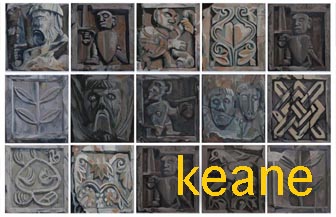I dipinti di Keane dei mulini e delle acque nella valle di Corsonna non stanno da soli. Fanno parte di un vasto corpus in cui l’artista documenta ciò che stava scomparendo e sta scomparendo nell’area di Barga, dalle suore di Barga alla cultura dei Pennati, alle sculture fiorite di Cristo e Madonna che un tempo si ergevano quasi ad ogni incrocio nella Garfagnana. Ma questa mostra è più di una semplice scomparsa di un importante mezzo di sostentamento economico dell’area. Dietro ai dipinti possiamo percepire una certa nostalgia per la perdita di una coscienza collettiva riguardo alla sacralità delle acque.
Nelle antiche culture che un tempo abitavano la Garfagnana, la Lunigiana e l’area della Lucchesia, le acque e la terra erano considerate poteri vitali collegati a forze femminili di fertilità e nascita. In molte Pieve, queste forze venivano rappresentate da simboli delle acque, come cerchi concentrici, sirene con due code, serpenti e foglie splendide. E infatti, numerosi piccoli ruscelli originano nelle grotte e nelle fenditure della terra nell’area. Scorrono giù dalle montagne nella valle del Serchio. Erano sostenuti dai mulini dipinti da Keane e fertilizzavano i terreni sulle colline intorno alla valle. Per secoli hanno sostenuto un mezzo di sostentamento che collegava i borghi in montagna con le città nella valle del Serchio. L’area è ancora estremamente fertile e verde, sostenuta da una forte circolazione dell’umidità che proviene dalla terra. La rugiada del mattino presto e le ricorrenti piogge diffondono le caratteristiche fertilizzanti delle acque in tutta l’area. E la rugiada è sempre stata un elemento sacro. Collega direttamente il cielo e la terra, così come lo spirito e la materia. Riflette in modo splendido i raggi dorati del sole del mattino.
Stiamo parlando di una “geografia sacra” antica qui, che mi è familiare dall’area del Lago di Bolsena, cuore della cultura etrusca. Il paesaggio è attraversato da numerose vie cave, con canali d’acqua e piccole cascate accanto ad esse. Portavano le acque sacre alle piccole aree di terreno accanto ad esse, dove gli agricoltori coltivavano viti, mais e verdure. Ma le strade cave erano anche strade sacre, che portavano nel ventre della Madre Terra, il luogo da cui proviene e a cui ritorna ogni vita. Facevano spazio a processioni sacre dalle colline – dove vivevano le persone – alle valli sacre, dove seppellivano i morti e dove c’erano templi in cui si celebrava il sacro matrimonio tra la Madre Terra e il Padre Cielo, specialmente ai solstizi. Nella religione etrusca non c’era separazione tra spirito e materia: nella loro unità si supponevano si celassero i segreti della vita, della morte e della rinascita, il ciclo eterno della vita. L’acqua era l’elemento di connessione e la sua fluidità e il movimento della sua energia erano importanti valori e pratiche sacre. Erano coltivati con una vasta gamma di usanze culturali e festività, guidate da sacerdotesse e sacerdoti della dea.
È qualcosa da ricordare nel mondo moderno, in cui beviamo acqua dal rubinetto e da bottiglie di plastica. È anche un motivo per onorare le numerose persone e gruppi in Italia e in tutto il mondo che lavorano per il ripristino della sacralità delle acque e per la cura, la pulizia e il ripristino delle sue energie che favoriscono la vita. –
Article by Selma Sevenhuijsen
 |
 |
 |
 |
The sacredness of the waters
Keane’s paintings of the mills and the waters in the Corsonna valley are not standing on their own. They are part of an extensive oeuvre in which the artist documents what was and is vanishing in the Barga area, from the Barga nuns to the culture of the Pennati, to the flowered sculptures of Christ and the Madonna that once stood at nearly every crossroad in the Garfagnana. But there is more to this exhibition than the vanishing of an important economic livelihood from the area. Behind the paintings we can feel a certain nostalgia about the loss of a collective consciousness about the sacredness of the waters.
In the ancient cultures who once inhabited the Garfagnana, the Lunigana and the Lucchesia area, the waters and the earth were considered to be lifegiving powers connected to feminine forces of fertility and birth giving. In many Pieves these were represented by symbols of the waters, like concentric circles, double tailed mermaids, snakes and beautiful leaves. And indeed, numerous little streams originate in caves and fissures in the earth in the area. They stream down from the mountains into the Serchio Valley. They were sustained by the mills painted by Keane, and fertilised the plots of lands in the hills around the valley. For ages they supported a livelihood that connected the hamlets in the mountains with the towns in the Serchio Valley. The area still is extremely fertile and green, which is supported by a strong circulation of the moistures that originate from the earth. The early morning dew and the recurrent rain showers spread the fertilising characteristics of the waters in the entire area. And dew has always been a sacred element. It directly connects heaven and earth, as well as spirit and matter. it reflects in a beautiful manner the golden rays of the morning sun.
We are speaking of an ancient ‘sacred geography’ here, that is familiar to me from the area of the Lago di Bolsena, the heart of the Etruscan culture. The landscape there is intersected by numerous hollow roads, with water channels and small waterfalls next to them. They brought the sacred waters to the small plots of land next to them, where farmers grew vines, corn and vegetables. But the hollow roads were also sacred roads, right into the belly of Mother Earth, the place where all life is coming from and returning to. They gave space to sacred processions from the hills – where people lived – to the sacred valleys, where they buried the dead, and where there were temples in which the sacred marriage between the Earth Mother and Father Sky were celebrated, especially at the solstices. In the Etruscan religion there was no separation between spirit and matter: in their oneness was supposed to lay the secrets of life, death and rebirth, the eternal cycle of life. Water was the connecting element, and its fluidity and the movement of its energy were important sacred values and practices. They were cherished by a wide range of cultural habits and festivities, guided by priestesses and priests of the goddess.
It’s something to remember in the modern world, in which we drink our water from the tap and from plastic bottles. It is also a reason to honour the many individuals and groups in Italy and around the world who work for a restoration of the sacredness of the waters, and for the maintenance, the cleaning and the restoration of its life enhancing energies.
Article by Selma Sevenhuijsen



